On this page, I will give an account of a few less well-known variants of chess that have existed as traditional games as well, primarily enlarged variants.
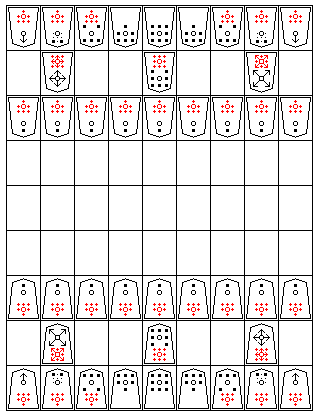
First, I will discuss Sho Shogi, the predecessor of the modern game of Shogi, as an introduction to the enlarged versions of the game.
This form of the game does not include the unique feature of modern Shogi of re-entering captured pieces on the board. The rules will be described in full here, although they are very similar to those of modern Shogi, except for the absence of drops, and the presence of one new piece, the Drunk Elephant.
Except for the King and the Gold General, all the pieces promote when they reach the last three rows of the board. Promotion is optional, except when the unpromoted piece would no longer be able to move, and can take place on any move that ends with the piece involved on the last three rows. The pieces are shown with their moves illustrated on them, and with the moves of their promoted forms in red below them.
The third row of pieces each player has consists of nine pawns; pawns promote to Gold General.
The second row consists of a Bishop on the player's left, and a Rook on the player's right, and a Drunk Elephant in the middle of the row. The Bishop promotes to Dragon Horse and the Rook to Dragon King, in each case adding the ability to move one square in the direction opposite to the normal movement of the piece. The Drunk Elephant promotes to a Crown Prince; it has the same move as a King, and once it exists, both the King and the Crown Prince, in either order, need to be captured for the player with a Crown Prince to be defeated.
The first row consists of Pikeman, Horse, Silver General, Gold General, King, Gold General, Silver General, Horse, and Pikeman.
Except for the King and the Gold General, all these pieces promote, and they promote to the Gold General.
The Pikeman can only move forwards on its file.
The Horse moves like a Knight, but can only make its two forwardmost moves.
The Silver General moves one space diagonally, or one space forwards.
The Gold General moves one space in any direction except diagonally backwards.
The King moves one space in any direction.
Several enlarged forms of Japanese chess exist. At one time, it was believed that only the rules to Tsiu Shogi, the smallest of the enlarged versions, on a 12 by 12 board, survived. Now, the rules to the other enlarged games have been rediscovered, and there are a couple of web sites which discuss them. For the moment, however, I will only go as far as discussing Tsiu Shogi (also known as Tsui Shogi or Chu Shogi) on this web page.
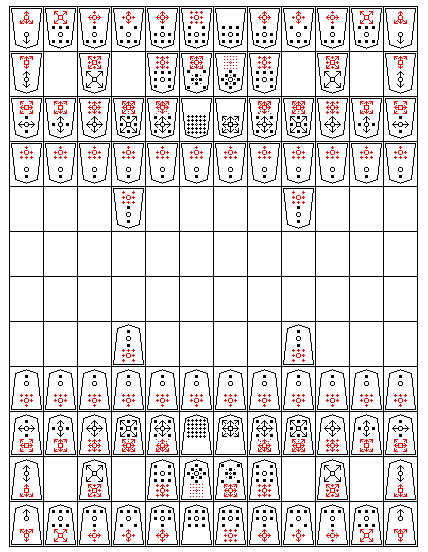
The diagram at left shows the Tsiu Shogi arrangement as it was known prior to the rediscovery of the other larger forms of Shogi. Although for the most part it has the same symmetry as that of a normal Shogi board, each player's own Drunk Elephant being to his right of his King, and each player's own Phoenix being to the right of his Ki-Rin, the two Lions and the two Fleeing Kings are shown facing each other on the same file. The modern arrangement reverses the Lion and Fleeing King of the player shown at the top of the board (i.e., the one that would be called Black in Western chess, although this is a term not applicable to Shogi, where the two sets of pieces have the same color, and only face in opposite directions) so that the Fleeing King is always to the player's own right of the Lion.
Although the diagram shows the older arrangement, the pieces are shown with their recently rediscovered powers, which, in a few cases, differ from those they were formerly believed to posess.
Pieces promote optionally when they make a move that ends in the last four rows of the board.
In each player's fifth row, the only piece present is in the fourth space from each side, and is the Adjutant, which moves only one space, either forwards or backwards. It promotes to a Drunk Elephant, which may move one step in any direction except directly backwards.
The fourth row consists of twelve Pawns. As in Shogi, they can only move one space directly forwards, and they promote to a Gold General, which can move one space in all directions except diagonally backwards, again as in Shogi. This had not been known for certain until recently, but had normally been assumed.
The third row consists of Sideways-Goer, Straight-Goer, Flying Chariot, Dragon Horse, Dragon King, Lion, Fleeing King, Dragon King, Dragon Horse, Flying Chariot, Straight-Goer, and Sideways-Goer.
The Sideways-Goer moves any distance horizontally, and one space vertically. It promotes to a Flying Pig, which moves both as a Bishop and any distance horizontally.
The Straight-Goer moves any distance vertically, and one space horizontally. It promotes to a Flying Ox. This promoted piece had formerly been believed to have only the move of a Bishop, but is now considered to move either as a Bishop or any distance vertically, making the moves and promotions of the Straight-Goer and Sideways-Goer symmetrical.
The Flying Chariot moves any distance orthogonally, as a Rook. It promotes to a Dragon King, which may move either as a Rook or one space diagonally.
The Dragon Horse moves as a Bishop, or one space orthogonally. It promotes to a Horned Falcon, which has the move of the Queen in all directions except directly forwards, where it has the move of a Lion.
The Dragon King moves as a Rook, or one space diagonally. It promotes to a Flying Eagle, which has the move of the Queen in all directions except the two forwards diagonal directions, in which it has the move of a Lion.
The move of the Lion was not fully known until recently. It is now known that it has the following powers:
Also, while a Lion may capture another Lion that is only one square away from it without any limitation, it may only capture one that is two squares away if it is undefended.
The Lion does not promote.
Note that since the Horned Falcon and the Flying Eagle only have the move of a Lion in some directions, it would appear that they cannot return to their starting square through a second single-step move as a Lion can. Also, I was not certain if the Flying Eagle can mix the two forwards diagonal directions in a Lion move. But further searching has allowed me to find out that the situation is actually this: if a Horned Falcon or a Flying Eagle makes a capture after a single step Lion move, it can return to its starting square, but the Flying Eagle may not mix the two diagonal directions to end up with the net displacement off of either of those diagonals of two squares forwards that might seem possible.
The Fleeing King was formerly believed to have the same move as the Retreating Chariot, but is now known to have the move of the Queen. It does not promote.
The second row consists of Retreating Chariot, a vacant square, Angle-Goer, a vacant square, Blind Tiger, Ki-Rin, Phoenix, Blind Tiger, a vacant square, Angle-Goer, a vacant square, Retreating Chariot.
The Retreating Chariot moves any distance vertically forwards and backwards only. It promotes to a Whale, which may move either any distance vertically forwards and backwards, or any distance in the two backwards diagonal directions.
The Angle-Goer, or Bishop, has the move of a Bishop. It promotes to a Dragon Horse, which can move any distance diagonally, or one space orthogonally.
The Blind Tiger moves one space in any direction except directly forwards. It promotes to a Flying Stag, which can move any distance vertically forwards and backwards, or one space either horizontally or diagonally.
The Ki-Rin, sometimes called a Unicorn, but, which, if an English name is needed, might be more accurately called a Rainbow Dragon, moves either one space diagonally or two steps orthogonally, leaping intervening pieces. (Note that it is not claimed to have a Lion move in the orthogonal directions.) It promotes to a Lion.
The Phoenix moves either one space orthogonally, or two steps diagonally, leaping intervening pieces. (Again, this is not a Lion move in the diagonal directions.) It promotes to a Fleeing King.
The first row consists of Pikeman, Horrible Panther, Copper General, Silver General, Gold General, King, Blind Tiger, Gold General, Silver General, Copper General, Horrible Panther, and Pikeman.
The Pikeman moves any distance vertically forwards only. It promotes to a White Horse, which can move any distance vertically forwards or backwards, and any distance diagonally forwards only.
The Horrible Panther can move one space in any direction except sideways. It promotes to an Angle-Goer, with the move of a Bishop.
The Copper General can move one space forwards, backwards, or one space diagonally forwards. It promotes to a Sideways-Goer, which can move any distance sideways, or one space orthogonally forwards or backwards.
The Silver General can move one space diagonally, or one space forwards. It promotes to a Straight-Goer, which can move any distance forwards or backwards, or one space sideways.
The King can move one space in any direction, and its capture is the object of the game. It does not promote.
The Drunk Elephant moves one space in any direction except orthogonally backwards. It promotes to a Crown Prince, which moves as a King, and which, once it exists, must also be captured to defeat the player that has one.
Although I have read that there were enlarged versions of Chinese Chess, the only versions I have found information on are:
One could also note the post-Revolutionary game Lizhangqi, which is a game somewhat similar to Stratego, and the game known in English as The Jungle Game, without hidden pieces, but with capture by rank as in Stratego.
No traditional variant which is simply Chinese Chess on a larger board with added pieces had turned up. The seven-player version is described on the next page, as it involves a large picture that would be slow to download.
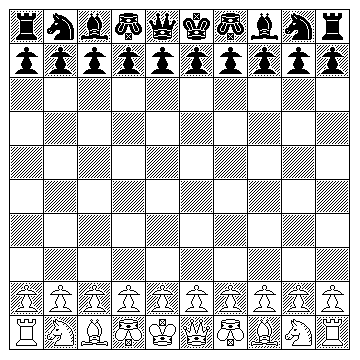
As the rules for Mongolian Chess, or Shatar, were given on the preceding page, I will describe Hiashatar, its enlarged variant, here.
Note that in the array shown, each player's King is on the right of the Queen from that player's viewpoint. This is encountered as a less-frequent variation of the initial array in Shatar as well.
The one new piece in this game, the Bodyguard, depicted as an upside-down King, moves either one or two steps, in an orthogonal or diagonal line. It does not give check; an enemy King is not threatened by it being in a position to move to the square it occupies. There are some ambiguities in the available accounts of the rules of Hiashatar regarding its normal power of capture; some say that it can only capture when moving diagonally. A piece, other than a Knight, that is adjacent to a Bodyguard, can only move one square.
The restrictions on the type of checkmate found in Shatar are not present in Hiashatar, and the Queen has the move found in normal Chess.
The other distinctive rules of Shatar may apply, however: Bare King being a draw, and only the King Pawn being allowed to move two spaces on its first move.
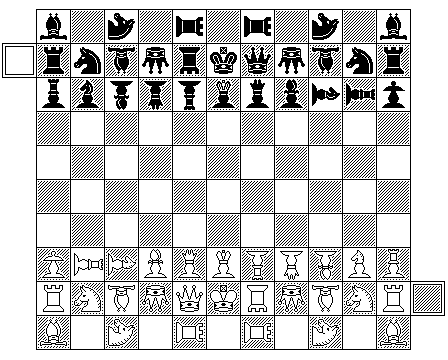
Historically, a number of enlarged variants of Chess were developed with Chaturanga or Shatranj as their basis. One of those which has received the most acclaim for its playability is the version of Great Chess attributed to Tamerlane.
One of the consequences of its popularity is that the Dabbaba (which means War Machine) has the standard Fairy Chess move of the Dabbaba in this game; several other forms of Great Chess also had pieces with this name, but with considerably different moves.
The third row of pieces is composed of twelve pawns. They move as modern Pawns, but have no double-step first move. These pieces will normally be smaller replicas of the other pieces, perhaps on an extended base, as the diagram at left suggests. This is because this indicates which piece they will promote to; thus, the Rook's Pawn on the player's right will only promote to a rook; this is true even if it has made a capture and moved to the Knight file, unlike the case in Malay chess.
The sequence of pawns, from left to right is Pawn of Pawns, Dabbaba's Pawn, Camel's Pawn, Bishop's Pawn, Fers' Pawn, King's Pawn, Wazir's Pawn, Giraffe's Pawn, Taliah's Pawn, Knight's Pawn, and Rook's Pawn.
The King's Pawn promotes to a Prince; this piece has the same move as the King, and, according to some sources, serves as a second King that the opponent will also have to capture to win. However, another rule of the game to be explained later gives reason to doubt this.
The Pawn of Pawns, when it reaches the last rank, initially must stay on the square it reaches, but is immune from capture there. When a situation exists where either two enemy pieces may be forked by a Pawn, or an enemy piece could be attacked by a Pawn and be unable to escape that attack, then the Pawn of Pawns can be moved from the enemy's back rank to the square from which this attack can be made. That square, in addition to being empty, may also contain an enemy piece, which that move would capture. It then continues to move as a Pawn, but when it reaches the enemy's back rank a second time, it is promoted to an Adventitious King, which, like a Prince, has the move of the King, and, again, according to some sources, acts as an additional King that must be captured to win; but again, another rule of the game gives reason to doubt that this is the case.
The second row consists of Rook, Knight, Taliah, Giraffe, Fers, King, Wazir, Giraffe, Taliah, Knight, and Rook.
The Rook, Knight, and King move as in modern chess. The Taliah moves as a Bishop, except that it cannot make a move of only one step. The Giraffe makes a move that begins with one diagonal step, and then continues orthogonally for three or more steps after a course change of 45 degrees; thus, it may not move so as to displace itself like a Knight (the same displacement as a diagonal move plus one orthogonal move) or a Camel (the same displacement as a diagonal move plus two orthogonal moves). Note that while it must move three or more steps orthogonally, it still cannot ignore pieces blocking it on the squares it must traverse in the beginning part of its move, as well as any on squares at which it could stop (This is specifically noted despite being reasonable and obvious to many readers because it departs from current conventions in Fairy Chess). The Fers moves one step diagonally, and the Wazir moves one step orthogonally.
The first row contains pieces only on every second square. The sequence begins with the Bishop (or Elephant), a vacant square, the Camel, a vacant square, a Dabbaba, a vacant square, a Dabbaba, a vacant square, a Camel, a vacant square, and a Bishop.
The Bishop moves as in modern Chess. The Camel has an elongated Knight's move, consisting of a displacement of one unit in one orthogonal direction and three units in a perpendicular direction. The Dabbaba moves two squares orthogonally, and may jump over any intervening piece without affecting it.
The King cannot castle, but, in addition to the creation of a Prince and an Adventitious King, it has special moves to avoid checkmate. The first time the King is checkmated, or stalemated, it can exchange places with one of its own men.
The two extra squares tacked on to the two sides of the 11 by 10 board are not normal squares that any piece can enter; they are citadel squares. Only the King can enter the citadel square on the opponent's side of the board; it is immune from capture there. Only the Adventitious King may enter the citadel on the player's own side of the board to block the other player's King from entering it.
Entering a citadel square, and becoming immune from capture, does not win the game. Some sources claim that it draws the game, unless the King elects to exchange places immediately with either a Prince or Adventitious King that it has.
This rule led me to question whether the Prince or Adventitious King could actually function as substitute Kings, since it seemed inconsistent with that.
Even if a King were threatened with checkmate, but there was a Prince or an Adventitious King on the board, then no advantage would be gained by the King moving into the citadel. In either case, the result would be equivalent: either the King is mated, and the opponent now has to mate the Prince or Adventitious King - or the King moves into the citadel, exchanges places with the Prince or Adventitious King, and now the opponent must mate the King, located on the same square, and with the same powers of movement, as the Prince or Adventitious King in the other case.
On the other hand, since a Prince is obtained by promoting the King's Pawn, and the Adventitious King by twice promoting the Pawn of Pawns, those pieces are sufficiently difficult to obtain that the reward of an alternate King is not unreasonable. That a King can draw the game by moving into the citadel is also not unreasonable; while the extra option of avoiding the draw by an action essentially equivalent to allowing a mate to take place might seem superfluous, as it only saves the opponent effort, it could well have suited the taste of Chess players of the time as being a way to avoid an indignity to the King. Thus, the inconsistency I percieved may have been more apparent than real, resting anachronistically on the coldly practical perspective so characteristic of modern times.
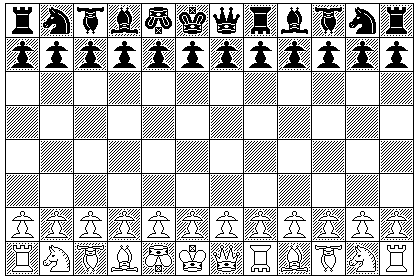
Our modern game of Chess became popular, and began to displace its predecessor, Shatranj, some time in the late 1400s (the late 15th Century). The modern move of the Bishop, if not that of the Queen, had been known in Europe some time before that, however. A piece called the Courier had the move of the modern Bishop in an enlarged game known as Courier Chess, of which historical records exist dating back to the year 1202. This game continued to be played in the German village of Ströbeck up to the early 1800s (the early 19th Century).
Note that in the initial array of Courier Chess, the positions and colors of the King and Queen are reversed from those which are conventional for normal Chess.
The second row of pieces on each side consists of twelve Pawns, having the modern Pawn move.
The first row consists of Rook, Knight, Alfil, Courier, Man, King, Fers, Sneak, Courier, Alfil, Knight, and Rook.
The Rook, Knight, and King move as in modern Chess.
The Alfil moves two spaces diagonally, ignoring intervening pieces.
The Courier moves as the modern Bishop.
The Man moves one square in any direction, like a King, but is only an ordinary piece.
The Fers moves one space diagonally.
The Sneak moves one space orthogonally.
Pawns do not normally move two spaces on their first move, nor is there castling; instead, a series of special moves, each one two squares forwards, are made by each player before the game proper starts (where Q stands for Fers): KRP-R4, QRP-R4, QP-Q4, Q-Q3.
Attempts have been made to modernize the game, one in 1824 and one in 1971. The one in 1971, Modern Courier Chess, changed the moves of several of the pieces. Even that of 1824 by Albers made a number of changes, although it was less radical.
The minimum changes for a modernized Courier Chess, I would think, would be to eliminate the compulsory starting moves, allow a two-step first move for all the Pawns at their first move, and reverse the initial location of the King and Queen (as well as the Man and Sneak with them, thus mirror-reflecting the entire array). To re-introduce castling, as a three-step move by the King, and give the Queen its modern move instead of that of the Fers, as was done in Albers' 1824 version, would also be reasonable.
Beyond this, Albers' version made other changes that did not seem necessary to me; allowing the Alfil to move one space in addition to two spaces; giving the Man the Knight's move in addition to its own, and giving the Sneak the Man's move. Also, in his game, a Pawn reaching the eighth rank promoted two turns later.
Modern Courier Chess, however, makes even more extensive changes.
Changing the Alfil's move in some way, however, is reasonable, since a piece that only moves two squares diagonally can only reach a very limited part of the board. One could make it a Taliah, able to move like a Bishop except not only one square, or one could give it the other old Bishop move of one square diagonally or one square forwards, as seen in Malay chess. Also, perhaps castling should be a four-square move by the King, to allow it to reach the same configurations as found in normal Chess, or only a two-square move, since the other special move, by the Pawn, is two squares instead of one.
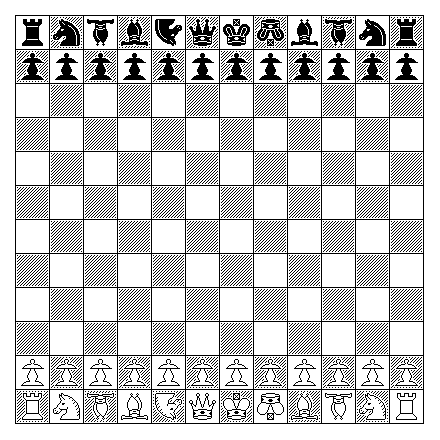
A large number of other extended versions of Chess have been devised over the centuries. Many have just one or two added pieces. Until I came across the version pictured at left, I had not seen an enlarged version of Chess that was an obvious third choice to include on this page. Upon checking again, however, I see that there is one version that came very close to qualifying, but which had just one problem: the description of the move of one of the pieces was not, in my estimation, completely unambiguous. I have now added a description of the game on the next page.
One that came close was a version known as Grande Acedrex, which was described in an old manuscript commissioned by Alfonso X of Seville, as it had a variety of additional pieces that was second only to that of Timur's Chess. But this game, which did not appear in that manuscript, but which is credited to Alfonso X in the book Chess Eccentricities, appears to me to be a much more playable game, as well as being representative of a large class of enlarged versions of Chess.
The pieces on the back rank are Rook, Knight, Unicorn, Bishop, Counsellor, King, Queen, Fool, Bishop, Unicorn, Knight, Rook.
The Unicorn in this game has a move that is found in many enlarged versions of Chess: it can move as either a Bishop or a Knight on each move. The Counsellor can move as a Knight, or one space in any direction, like the King. The Fool can only move one space in any direction, so it moves like the King, but is only an ordinary piece.
The Unicorns are two powerful pieces added to the game, and the two other pieces are less powerful, yet still powerful enough to be valuable. Of the many games that added a Bishop plus Knight, or a Rook plus Knight, or both, or other similar pieces, this one seemed to have a varied enough complement of pieces to be interesting, but not so powerful as to be overwhelming.